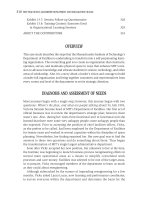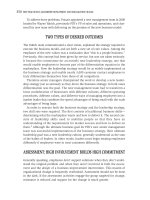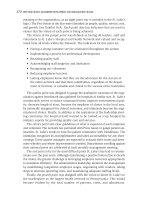Tài liệu Best Practives in Leadership Development & Organization Change 42 docx
Bạn đang xem bản rút gọn của tài liệu. Xem và tải ngay bản đầy đủ của tài liệu tại đây (169.03 KB, 10 trang )
Room temperature:
• All individual heating systems in each room were cleaned and upgraded.
• Individual room thermostats were added with signage explaining how to adjust the
temperature.
• Individual fans were provided as requested.
• Window darkening coating was placed on the interior of the windows.
• The return (fresh) air flow was increased to the pediatric unit. In addition, the venti-
lation unit was replaced. (10/03)
Staff sensitivity to inconvenience and staff attitude toward visitors:
• Families were provided 20 percent cafeteria discount cards. (9/01)
• Parents choosing to stay with their child were given hygiene supplies. (9/00)
• A VCR was placed in every child’s room with appropriate controls. (11/02)
• “Please Do Not Disturb” signs were placed in the unit. (1/02)
• All units had distributed welcome pamphlets (and signs were updated). (5/03)
• Snack, soda, and juice vending machines were made available in an area conve-
niently adjacent to the pediatric floor.
The changes that were instituted were measured by the results of the Press Ganey
Report results from July 1, 2003, to September 30, 2003 (see Exhibit 16.7). An
increase in scores was shown in all five areas of the needs assessment.
CASE #3: Point of Star—Cost and Quality
Title: “Guidelines for the Use of Interventional Cardiology Medications in the Cardiac
Catheterization Lab—A Multidisciplinary Approach”
Project team leader: Howard C. Cook
Utilizing the principles of value analysis and evidence-based medicine, a program
was developed highlighting guidelines for the use of glycoprotein IIb/IIIa inhibitors
(abciximab [ReoPro], eptifibatide [Integrilin]), and the direct thrombin inhibitor
bivalirudin (Angiomax) in interventional cardiology procedures. The goal of this
project was to assure optimum patient outcomes and maximum financial efficiency.
It was recognized that abciximab was utilized in approximately 60 percent of all
cases involving these agents. This agent was also the most expensive of the three
agents usually employed. A thorough review of the medical literature was
undertaken to see whether there were specific indications or patient types who
benefited most form the use of abciximab. For all others, the preferred agent would
be eptifibatide (or bivalirudin, if the clinical situation was appropriate). At the same
time, a national survey of top cardiac hospitals (based on Solucient data) was
conducted to see whether they had established criteria for the use of these products.
Once all data were reviewed, a proposal was presented to the cardiology steering
committee for approval. At that time, criteria were fine-tuned and the project was
approved. Educational signage was displayed in all procedure rooms, indicating
situations in which abciximab would be preferred and requesting the use of
eptifibatide (or bivalirudin) in all other patients. Target drug usage data, as well as
380
BEST PRACTICES IN LEADERSHIP DEVELOPMENT AND ORGANIZATION CHANGE
cart_14399_ch16.qxd 10/19/04 1:19 PM Page 380
concomitant interventional medications used, were documented to determine
compliance to approved criteria. Physicians who consistently used abciximab outside
of approved criteria were contacted and the program was reviewed. There was a
consistent reduction in the number of cases that fell outside of established criteria as
the program continued. Success of the project was measured by evaluating the cost
per case of interventional procedures in which the target drugs were used. Since its
beginning in April 2003, the estimated annual savings to the institution is in excess
of $250,000. There have been no reports of adverse drug events as a result of the
therapeutic preferences of this program to date.
CASE #4: Point of Star—People
Title: “Creating a Best Place to Work”
Project team leader: Joe Pinto, director, service improvement
St. Luke’s wished to be recognized nationally in clinical outcomes, cost-effective care,
and patient satisfaction. To achieve this recognition, the director of service
improvement looked to Press Ganey to provide a large medium in which St. Luke’s
could compete against over 1,600 hospitals across the country. Using the Press Ganey
survey as well as its research resources, St. Luke’s was able to identify the questions that
were highly correlated with employee friendliness and courtesy. As part of the analysis,
St. Luke’s examined the questions that were highly correlated with the likelihood of
patients to recommend the hospital to others. Following the assessment, a plan was
devised based on the principle that happy employees correlate to satisfied customers,
which in turn leads to patients that will recommend St. Luke’s to other people.
Following the research and assessment of the future goal, the first step in the
implementation process began by creating a customer service program. This program
was mandated and was designed to illustrate the necessary steps to implement
appropriate customer service behaviors and standards of performance. Key areas
ranged from conflict resolution to service recovery and etiquette. The second step
was creating the employee recognition and reward committee. This committee of
staff members is charged with awarding the PCRAFT (pride, caring, respect,
accountability, flexibility, teamwork) award to twelve hospital employees per year
(see Exhibit 16.2). These employees are required to consistently exhibit the values of
the organization, and documented examples have to be included in their respective
nomination form. The third key step in the strategy process was the implementation
of awards for departments’ patient satisfaction scores. The objective of the
departmental quarterly recognition program was to reward and recognize
employees, managers, and departments for outstanding achievement related to
patient satisfaction. To achieve recognition, a department must receive one of the
following:
• Highest percentile ranking on the survey
• Overall mean score that is highest above the hospital mean score
• Highest percentile ranking consistently (three quarters or more)
• Largest improvement in overall mean score
ST. LUKE’S HOSPITAL AND HEALTH NETWORK
381
cart_14399_ch16.qxd 10/19/04 1:19 PM Page 381
Following a win of this award, the department managers receive up to $100 to
be used on the department, accompanied by recognition from the COO and at
monthly management meetings. The final component of the overall strategy focuses
on individual achievement via the “High-5” recognition. A staff member who has his
or her name appear in patient letters, Press Ganey comments, over the phone, in
patient letters, or through Project Bravo recognitions—a St. Luke’s program that
recognizes employees for positive customer service—more than five times receives
a High-5 Award. The recognized employee receives a gift certificate to either a
restaurant or other outside facility, a letter from the COO, a pin with the slogan
“above and beyond,” and their name displayed on the Employee Wall of Fame.
The results of this comprehensive strategy are based on Press Ganey scores and
other major achievements. In 2003 marked achievements in Press Ganey scoring
included the following:
• The Environmental Services Department scored within the ninetieth percentile for
four consecutive survey periods in the measure of room cleanliness and staff
courtesy.
• The nursing staff ranked above the eightieth percentile in nurses’ attitude.
• Organizational achievements included a ranking over the eightieth percentile in
overall cheerfulness, eighty-fourth percentile in staff sensitivity to the inconve-
nience of being in a hospital setting, and eighty-third percentile in attitude toward
visitors.
Although the Press Ganey scores alone provided tangible proof of success, just as
valuable was being named in the “Best Places to Work Foundation for Pennsylvania.”
In the Top 100 Best Places, St. Luke’s ranked twenty-eighth in the large-size category
(employee number greater than 250). The award is based on a written summary of
practices, as well as an anonymous employee survey of randomly selected
employees. The employee survey represents 75 percent of the total grade.
LEADERSHIP COMMITTEE OUTCOMES
As leadership forum programming continued to evolve, the steering committee
established a linkage committee. The linkage committee membership was rep-
resentative of the entities within the network. The primary goal of the linkage
committee was to link education to changing behavior. To exercise this
goal, accountability grids were created following each leadership forum. The
accountability grids (Exhibit 16.8) contained expectations for senior and middle
management leaders with defined timelines as appropriate. The expectations
contained within each accountability grid related to the education provided at
the leadership forum.
Several works, born out of the leadership forum, have contributed sig-
nificantly to the organization’s definition of leadership skills. One of these
works is the leadership core competencies, which was the result of work
382
BEST PRACTICES IN LEADERSHIP DEVELOPMENT AND ORGANIZATION CHANGE
cart_14399_ch16.qxd 10/19/04 1:19 PM Page 382
accomplishments by the entire leadership team. Seven key competencies were
identified:
• Motivator
• Team builder
• Goal orientation
• Communicator
• Commitment to service
• Organized, prioritizing
• Resourceful
Each of these competencies has specific behavioral identifiers that further
define each competency. The management performance evaluation was
redesigned by an ad hoc group of managers who participated in the leadership
forum. This group designed a new management evaluation tool that incorpo-
rated the core leadership competencies (Exhibit 16.9).
An additional work that originated out of the leadership steering committee
was the development of a booklet on service excellence standards of perfor-
mance. This booklet clearly defines, in a behavioral way, the standards set for
“concierge service delivery” on the part of all members of the hospital team. All
new employees are required to attend concierge training as part of the orienta-
tion to the hospital.
ENDNOTES
1. Collins, J. (2001). Good to great. New York: HarperCollins.
2. Loehr, J., & Schwartz, T. (2003). The power of full engagement. New York: Simon &
Schuster.
ST. LUKE’S HOSPITAL AND HEALTH NETWORK
383
cart_14399_ch16.qxd 10/19/04 1:19 PM Page 383
384
BEST PRACTICES IN LEADERSHIP DEVELOPMENT AND ORGANIZATION CHANGE
Exhibit 16.1. Strategic Plan Goals and Objectives
Mission Statement. The mission of St. Luke’s Hospital and Health Network is
to provide compassionate, excellent quality and cost-effective health care to
residents of the communities we serve regardless of their ability to pay.
The entities constituting the St. Luke’s Hospital and Health Network will
accomplish this mission by
• Making the patient our highest priority
• Promoting health and continuously improving care provided to heal the sick
and injured
• Coordinating and integrating services into a seamless system of care
• Improving the level of customer service provided throughout the network
• Ensuring all health care services are relevant to the needs of the community
• Striving to maximize the satisfaction of our employees, patients, medical staff,
and volunteers
• Training allied health professionals, nursing and medical students, and
residents in a variety of specialties and to attract them to practice within
the network’s service area
Vision Statement. The entities of St. Luke’s Hospital and Health Network will be
nationally recognized for excellence in clinical outcomes, cost-effective care, and
patient satisfaction.
This vision will be achieved by
• Continuously improving patient, employee, volunteer, and physician
satisfaction
• Benchmarking clinical outcomes and improving the processes that lead
to optimal care
• Managing the resources of the network to minimize costs
• Partnering with physicians and other providers, recognizing our success is
dependent on cooperation and common goals
• Continuously updating our view of “reality” consistent with a rapid change
in the environment, technology, and the practice of medicine
cart_14399_ch16.qxd 10/19/04 1:19 PM Page 384









